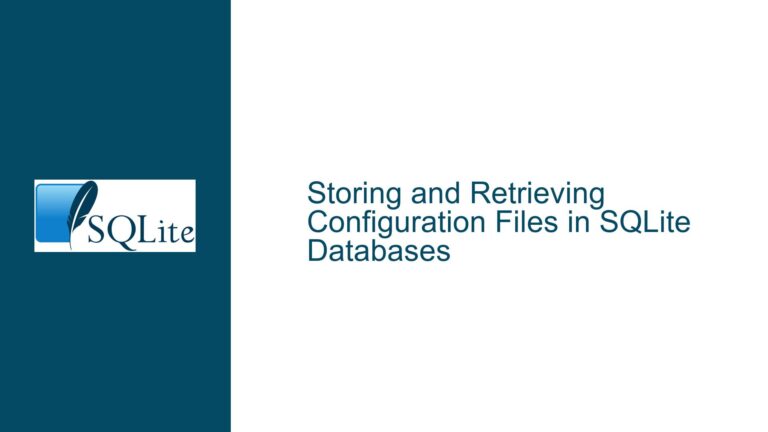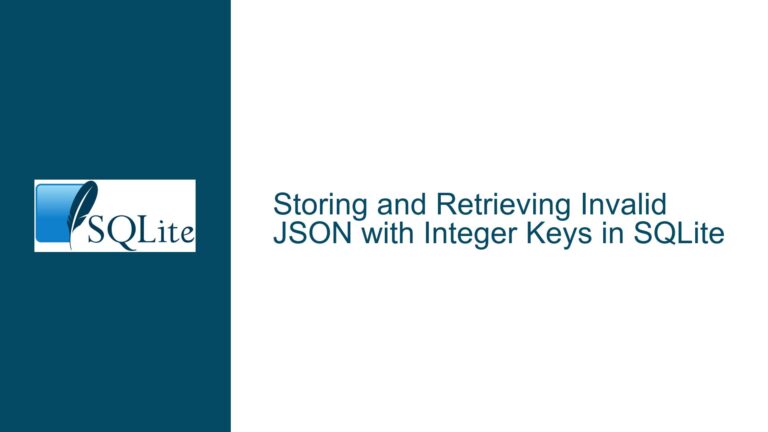Using Asynchronous Web Servers with SQLite: Performance and Concurrency Considerations
SQLite’s Synchronous API and the Reality of Concurrent Database Operations
The foundational challenge in pairing asynchronous web servers with SQLite stems from SQLite’s inherently synchronous design. The SQLite C library, which underpins all language-specific drivers and wrappers, operates synchronously: every database operation blocks the calling thread until completion. There is no native support for asynchronous I/O, event-driven callbacks, or non-blocking execution of queries. This creates a critical architectural constraint when integrating SQLite with asynchronous web frameworks, which rely on non-blocking operations to maximize throughput under high concurrency.
SQLite’s Write-Ahead Logging (WAL) mode introduces a layer of concurrency by allowing readers and writers to coexist without blocking each other. However, this concurrency is achieved through thread-level parallelism, not asynchronous execution. Each database connection operates synchronously, and while WAL mode permits a writer to proceed alongside readers, the writer must still acquire exclusive locks for commits. This distinction between concurrency (parallel operations across threads) and asynchronicity (non-blocking operations within a single thread) is often misunderstood. Asynchronous web servers excel at managing thousands of simultaneous network connections with minimal threads, but they cannot circumvent the blocking nature of SQLite’s API. If the database becomes a bottleneck—due to long-running transactions, schema locks, or disk I/O—the benefits of an asynchronous web server diminish, as threads or tasks will still block waiting for SQLite operations to complete.
The Rust ecosystem exemplifies this tension. Rust’s asynchronous runtime (e.g., Tokio) is designed for high concurrency with non-blocking I/O, but SQLite drivers in Rust (such as rusqlite or sqlx) wrap synchronous C library calls. Even when using spawn_blocking to offload database operations to a separate thread pool, the asynchronous runtime must still manage the overhead of task scheduling and context switching. This raises questions about whether the complexity of an asynchronous architecture is justified for SQLite-backed applications, particularly when the database itself cannot leverage non-blocking I/O.
Misinterpreting Asynchronous Reads, WAL Mode, and Thread-Based Concurrency
A common misconception arises from conflating SQLite’s support for concurrent readers in WAL mode with asynchronous I/O capabilities. WAL mode allows multiple readers to access the database while a single writer commits changes, but this is achieved through thread-level parallelism, not asynchronous execution. Each database connection—whether for reading or writing—operates synchronously. For example, a web server handling 100 concurrent HTTP requests might spawn 100 threads, each with its own SQLite connection. While WAL mode allows these threads to read without blocking each other or the writer, each thread is still blocked while waiting for its specific query to execute.
Asynchronous web servers, in contrast, aim to handle many connections on a small number of threads by using non-blocking I/O and event loops. However, if the database driver is synchronous, each database operation forces the event loop to block until the operation completes. This negates the primary advantage of asynchronous servers: the ability to process other requests while waiting for I/O. For SQLite, this means that even with WAL mode enabled, an asynchronous web server cannot execute queries in a non-blocking manner unless the database operations are offloaded to a separate thread pool. This introduces complexity, as developers must manage thread pools, task scheduling, and potential resource contention between the asynchronous runtime and database connections.
Another layer of confusion stems from SQLite’s file-based architecture. Unlike client-server databases (e.g., PostgreSQL), SQLite performs direct disk I/O within the application process. Asynchronous I/O at the filesystem level is theoretically possible but not exposed by SQLite’s API. The operating system may buffer writes or optimize disk access, but from the application’s perspective, every sqlite3_step or sqlite3_exec call remains blocking. This makes it impossible to achieve true asynchronicity without modifying SQLite itself or using experimental, non-standard extensions.
Mitigating Bottlenecks: Strategies for Balancing Async Servers and SQLite Workloads
To reconcile asynchronous web servers with SQLite’s synchronous nature, developers must adopt strategies that minimize blocking and maximize concurrency within the constraints of SQLite’s design. The first step is to profile the application to identify whether the database is the primary bottleneck. Tools like SQLite’s sqlite3_trace or Rust’s tracing crate can help measure query latency and identify long-running transactions. If most requests involve simple, fast queries (e.g., key-value lookups), the overhead of blocking operations may be negligible, and an asynchronous server could still yield benefits for non-database tasks (e.g., handling WebSocket connections or external API calls).
For applications with significant database workloads, consider the following approaches:
Connection Pooling with Thread-Based Concurrency: Use a thread pool to manage SQLite connections, allowing multiple synchronous operations to proceed in parallel. In Rust, this could involve the
rayoncrate or a dedicated pool of blocking tasks within Tokio. Each database connection must be confined to a single thread to avoidSQLITE_BUSYerrors, but connection pooling libraries (e.g.,r2d2) can streamline this process. While this does not eliminate blocking, it prevents thread exhaustion and ensures fair scheduling of database operations.Read-Only Replicas and Caching: Offload read traffic to read-only replicas or in-memory caches. SQLite supports attaching multiple databases, enabling a primary read-write instance and secondary read-only copies. For high-read workloads, tools like
litefscan automate replication across nodes. Caching layers (e.g., Redis) can further reduce the frequency of database accesses, mitigating the impact of synchronous queries.Deferred Writes and Batch Operations: Minimize write contention by batching updates and deferring non-critical writes to background tasks. SQLite’s
PRAGMA journal_mode = WALandPRAGMA synchronous = NORMALsettings can improve write performance by reducing disk synchronization, though this requires careful consideration of durability trade-offs.Alternative Databases for High-Concurrency Write Workloads: If the application requires high write throughput with non-blocking operations, consider migrating to a client-server database like PostgreSQL. Tools like
pgxordieselprovide asynchronous drivers in Rust, enabling true non-blocking database interactions within an asynchronous web server.
Ultimately, the decision to use an asynchronous web server with SQLite hinges on the specific workload and performance requirements. For applications where the database is not the dominant latency source, an asynchronous architecture may still offer benefits. However, developers must rigorously evaluate the interaction between the web server’s concurrency model and SQLite’s synchronous API to avoid unexpected bottlenecks.






